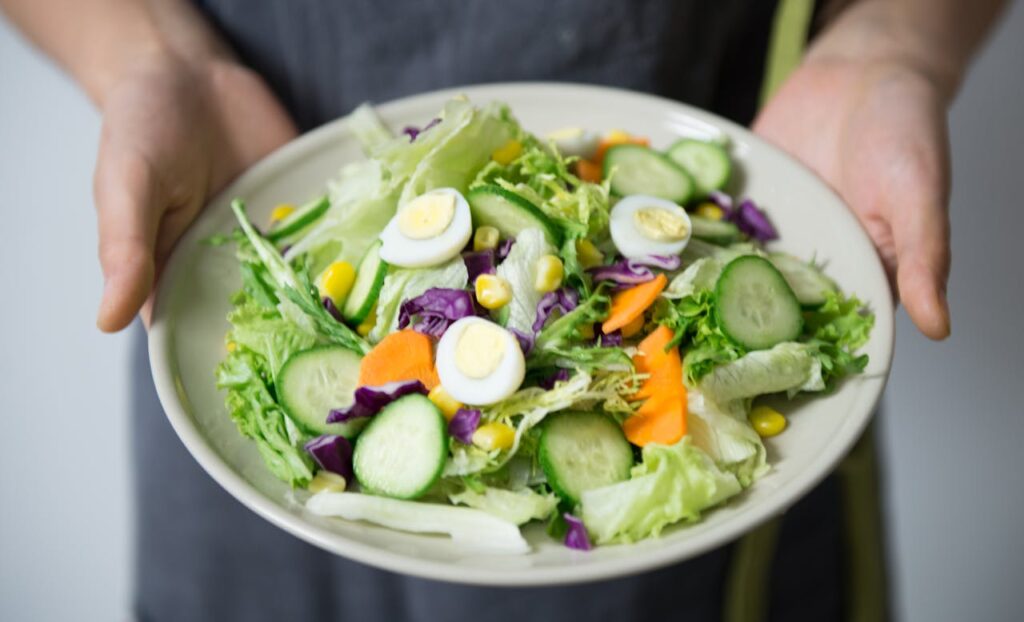Changing your diet doesn’t have to mean giving up your favorite foods or following restrictive plans. A healthier lifestyle starts with simple, sustainable steps that gradually transform your habits and improve your overall well-being. Whether your goal is to lose weight, increase energy, or simply feel better, these 10 simple diet tips will help you get started. Packed with actionable advice and insights, this guide will also answer some of the most common questions about healthy eating.
1. Stay Hydrated: The Foundation of Health

Water plays a vital role in almost every bodily function, from regulating body temperature to flushing out toxins. Dehydration can lead to fatigue, headaches, and even overeating, as thirst is often mistaken for hunger.
How to Get Started:
- Drink a glass of water first thing in the morning to kickstart your metabolism.
- Carry a reusable water bottle to stay hydrated throughout the day.
- Add natural flavors like lemon, cucumber, or mint to your water to make it more enjoyable.
Bonus Tip: Avoid sugary drinks like sodas and energy drinks. They add empty calories and spike your blood sugar, leading to energy crashes later.
2. Focus on Whole, Nutrient-Dense Foods

Whole foods—such as fruits, vegetables, whole grains, and lean proteins—are rich in essential nutrients like fiber, vitamins, and minerals. Processed foods, on the other hand, are often stripped of nutrients and loaded with unhealthy additives.
How to Get Started:
- Replace white bread with whole-grain options.
- Swap chips for crunchy veggies like carrots or cucumber slices paired with hummus.
- Choose fresh fruits instead of sugary desserts.
Whole foods also help you feel fuller for longer, reducing the temptation to snack on less healthy options.
3. Create Balanced Meals
Eating a balanced meal ensures you get the right mix of macronutrients: carbohydrates, proteins, and fats. This combination stabilizes blood sugar levels, boosts energy, and keeps hunger at bay.
How to Balance Your Plate:
- Half your plate: Vegetables and fruits for fiber, vitamins, and antioxidants.
- A quarter of your plate: Protein sources like chicken, fish, beans, or tofu to support muscle repair and satiety.
- A quarter of your plate: Whole grains like quinoa, brown rice, or whole-wheat pasta for sustained energy.
4. Practice Portion Control
Portion control is not about depriving yourself; it’s about eating the right amount for your body’s needs. Overeating—even healthy foods—can lead to weight gain and sluggishness.
How to Start Controlling Portions:
- Use smaller plates and bowls to naturally limit how much you serve yourself.
- Serve food in the kitchen rather than at the table to avoid second helpings.
- Listen to your body and stop eating when you feel 80% full—your brain needs time to catch up with your stomach.
5. Reduce Added Sugar
Sugar lurks in more foods than you might expect, from salad dressings to yogurts. Excess sugar can lead to weight gain, energy crashes, and increased risk of chronic conditions like diabetes and heart disease.
Easy Swaps:
- Replace sugary drinks with sparkling water or unsweetened herbal teas.
- Opt for plain yogurt and add fresh fruit for sweetness instead of pre-flavored varieties.
- Choose whole fruit over fruit juices to get natural sugars along with fiber.
6. Slow Down and Eat Mindfully
Rushed meals or eating while distracted often lead to overeating. Mindful eating involves being present during meals and paying attention to your hunger and fullness signals.
How to Eat Mindfully:
- Sit down at a table for meals—avoid eating in front of the TV or your phone.
- Chew each bite thoroughly and savor the flavors.
- Take small bites and pause between them to give your brain time to register fullness.
7. Make Breakfast a Priority
Skipping breakfast can make you feel tired and lead to overeating later in the day. A nutritious breakfast fuels your body and mind for the day ahead.
Quick and Healthy Breakfast Ideas:
- Overnight oats with almond milk, chia seeds, and fresh berries.
- Scrambled eggs with spinach and whole-grain toast.
- A smoothie made with spinach, banana, almond butter, and unsweetened almond milk.
8. Plan and Prep Meals Ahead of Time
Meal prepping saves time, reduces stress, and makes it easier to stick to your healthy eating goals. It also helps you avoid impulsive, unhealthy food choices when you’re hungry.
Steps to Start Meal Prepping:
- Plan your meals for the week and make a shopping list.
- Cook larger portions of staples like grains, proteins, and roasted vegetables, and store them in separate containers.
- Pre-chop fruits and vegetables for snacks or recipes to save time during busy weekdays.
9. Incorporate Healthy Fats
Healthy fats are not the enemy! They’re essential for brain health, hormone production, and nutrient absorption.
Sources of Healthy Fats:
- Avocados
- Nuts and seeds (like almonds, chia seeds, and flaxseeds)
- Olive oil
- Fatty fish like salmon or mackerel
Be mindful of portion sizes, as fats are calorie-dense.
10. Stay Consistent and Be Kind to Yourself
The journey to a healthier lifestyle is not about perfection; it’s about progress. Small, consistent changes are more effective than drastic measures that are hard to maintain.
Tips for Staying on Track:
- Set realistic goals and celebrate small victories, like drinking an extra glass of water or preparing one healthy meal a day.
- Don’t let slip-ups derail you—acknowledge them, learn, and move on.
- Surround yourself with a supportive environment, whether it’s friends, family, or online communities.
Frequently Asked Questions (FAQs)
Q: How can I avoid unhealthy cravings?
A: Stay hydrated, eat balanced meals with protein and fiber, and keep healthy snacks like nuts or fruit readily available. Cravings often stem from dehydration, nutrient deficiencies, or boredom.
Q: Is it okay to indulge occasionally?
A: Absolutely! Indulging in moderation is a healthy approach. Treat yourself occasionally to avoid feeling deprived, but balance it with nutrient-rich meals.
Q: Can I still eat out while following these tips?
A: Yes! Look for menu items with grilled or baked proteins, plenty of vegetables, and whole-grain sides. Don’t hesitate to ask for dressings or sauces on the side.
Q: How long does it take to see results?
A: You may notice increased energy and better digestion within a week or two. Weight loss or other long-term benefits depend on your consistency and goals.
Q: What if I don’t have time to meal prep?
A: Start small. Even prepping snacks, like slicing veggies or portioning nuts, can make a difference. Consider batch cooking on weekends to save time during the week.
Final Thoughts
A healthier lifestyle doesn’t require perfection or extreme sacrifices. By incorporating these 10 simple diet tips into your routine, you can improve your health one step at a time. Remember, consistency is key. Start today—your future self will thank you!

